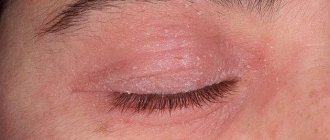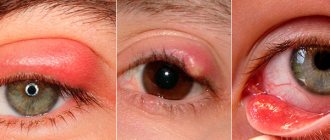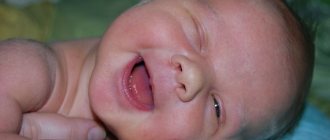Exotropia, or divergent strabismus, is observed more often in childhood, less often in adults. It manifests itself in one or two eyes as a violation of the synchronicity of the location of the eyeballs and their deviation from the optical axis to the temple.
An unstable exotropia, or a temporary, permanent and sensory form may be observed under the influence of alcohol, strong visual stress and other factors. In the absence of diagnosis and treatment of the temporary variety, more frequent recurrences of strabismus and transition to a permanent form are possible.
Treatment of exotropia is mandatory - with a conservative or surgical method; in addition, it is necessary to perform eye exercises. To prevent pathology, it is important to exclude influencing causes, visit an ophthalmologist in a timely manner, and if there is a slight deviation from the norm, inform the doctor.
Causes
Exotropia can be congenital or acquired. In the first case, it is provoked by:
- complicated heredity – cases when close relatives have a history of myopia, farsightedness, glaucoma, cataracts and other eye diseases;
- Cerebral palsy – cerebral palsy;
- premature birth, prematurity, immaturity of the nervous system and underdevelopment of the organ of vision;
- congenital pathologies and eye abnormalities;
- exposure to many factors on the fetus - abuse of alcohol, psychotropic and narcotic substances by the pregnant woman, infections (measles, scarlet fever, herpes, cytomegalovirus, ARVI, influenza, diphtheria).
During life, exotropia can develop due to the following factors:
- paralysis and paresis;
- sharp deterioration and impairment of visual acuity TEXT_LINKS;
- pathological conditions of the central nervous system;
- stressful situations;
- fear in childhood;
- infectious diseases;
- injuries of the organ of vision and abnormal development.
Strabismus in adults can be caused by glaucoma and cataracts, refractive error and myasthenia gravis, stroke and traumatic brain injury, multiple sclerosis and other somatic diseases.
Sequential esotropia
Serial esotropia is a condition in which esotropia changes the amount of deviation with a change in gaze direction. It can occur in both childhood and adulthood as a result of neurological, mechanical or myogenic problems. These problems may directly affect the extraocular muscles themselves, or may also be the result of conditions affecting the nerve or blood supply to these muscles or the surrounding bony orbital structures. Examples of conditions that cause esotropia may include sixth cranial nerve palsy, Duane syndrome, or orbital injuries.
Classification
Exotropia is of two types - rarely congenital, more often acquired. The first type is mainly diagnosed for somatic diseases - Down syndrome, Crouzon syndrome. Possible squinting of the eyes in newborns and up to 4 months is a sign of an inability to focus their gaze and insufficient development of the extraocular muscles.
The condition does not require correction with medications, occlusive dressings, or surgical interventions. For development, it is necessary to perform exercises with bright (green, yellow), black and white toys.
Divergent strabismus can occur constantly or periodically, under certain conditions. The permanent form is classified into 3 types:
- congenital - in case of birth trauma, complicated heredity, intrauterine infection and cerebral palsy, differential diagnosis is necessary from false or imaginary strabismus, which is observed in most newborns and is not a pathology;
- sensory – occurs due to deterioration in visual acuity of one eye, provoked by cataracts, glaucoma, trauma, clouding of the lens, as a result of which the affected eye is switched off from the vision process and the balance in the work of the eye muscles changes;
- secondary – after surgery to eliminate strabismus, if the operation was unsuccessful.
With divergent strabismus, one eye can squint or alternately. If the pathology did not arise in utero, then it can accompany a person permanently, temporarily, or when exposed to excessive visual load or toxic substances (sensory type of strabismus).
Why does the disease occur?
In medicine, there are two main types of diseases: congenital and acquired. The same applies to strabismus. Many people ask why a child can be born with an external defect. This trend directly indicates the presence of congenital problems that are inherited. These include Brown and Louis-Bar syndromes, as well as neurodevelopmental dysfunction.
The cause of congenital strabismus in children can be a pathological course of pregnancy or the presence of birth injuries. There are situations when a woman does not have enough oxygen during childbirth due to suffocation. This can easily become the basis for the appearance of an illness.
Now regarding the acquired causes of strabismus in children. These include:
- damage to the nerve endings that monitor the functioning of the extraocular muscles as a result of injury or infection;
- decreased visual acuity due to the presence of diseases such as farsightedness, myopia, retinal dystrophy or cataracts;
- swelling or swelling in the eye area;
- damage to the cerebral cortex or pituitary gland;
- severe stress, fear, psychological trauma;
- improper functioning of the thyroid gland.
We can conclude that it is not enough to protect the baby from exposure to infections and physical injuries. Strabismus can also develop as a result of an emotional breakdown. As you know, it is very easy to offend a child, so parents should not allow such a development of events.
Symptoms
The following signs and symptoms are characteristic of divergent strabismus, or exotropia:
- lack of binocular vision and double vision;
- squinting of one or both eyes towards the temple;
- noticeable deterioration in visual acuity of the pathological eye;
- there is no loss of mobility of the organ of vision;
- maintaining normal refraction;
- increase in the size of the constant angle of strabismus.
If the pathology is caused by paresis or paralysis of the eye muscles, the mobility of the organ is lost, the patient is worried about the lack of binocular vision, dizziness and headaches.
Due to the pathology, binocular vision and, accordingly, the perception of visible objects are impaired. This leads to a delay in the mental and physical development of the child, affects the character and mental state, and binocular vision is completely lost without proper treatment. In adults, neurological problems are diagnosed.
Symptoms
In most cases, parents notice the external manifestations of the disease. Due to improper physiological development, mothers and fathers understand that the child is not developing as well as they would like. So, the main symptoms include:
- Inability to concentrate on one point using both eyes. This sign is easy to identify by observing the baby’s facial expressions and facial expressions.
- Deviation of one eye up/down or left/right. If the child has obvious strabismus, then the symptom is easy to detect, otherwise only in bright light.
- Asynchronous eye movement. In principle, this is very easy to check. You need to show the baby the object, gradually moving it to the side, and watch the expression in the eyes. If the movements follow the same trajectory, everything is in order, but otherwise, strabismus is possible.
- To examine the object, the baby tilts his head. It becomes a full-fledged sign only if this is the child’s main way of looking at it.
- The baby often encounters obstacles. A classic example: leaving the bathroom, a child hits the door frame. You need to watch him, if this situation repeats constantly, there is cause for concern.
Strabismus in children (photo below) can be diagnosed only after they are 4 months old. Until this age, children's gaze is often unconcentrated. This is a temporary symptom that goes away after a few months. But if the problem persists, you need to consult a doctor.
In older children, experts identify additional signs:
- excessive sensitivity to light, pain appears in the eyes, they involuntarily close;
- blurred vision, objects are perceived unclearly, foggy;
- the eyes get tired quickly, the baby constantly complains of pain when reading or drawing;
- duality, the child cannot determine the number of objects shown to him.
Diagnostics
To diagnose pathology, an ophthalmologist examines the structures of the eye, conducts special tests to determine strabismus, and measures the angle.
It is important to identify and eliminate the provoking factor. If strabismus is caused by ophthalmological diseases, for example, cataracts, glaucoma, myopia, farsightedness, methods are selected to treat and correct the cause of strabismus. You may need to consult an infectious disease specialist or neurologist.
How to identify true strabismus
The diagnosis of strabismus is made only by an ophthalmologist. He must conduct a thorough examination and find out all the possible reasons that influenced the development of the disease. The ophthalmologist will also determine visual acuity using special tables with pictures of animals (after the child is 1 year old).
During the diagnosis, using special equipment, the angle of deviation, the degree of mobility of the eyeball in various directions are determined, and it is also assessed how friendly the work of the peephole is.
For this, special mirrors are used. If an ophthalmologist diagnoses “paralytic strabismus” (a deviation associated with paralysis of the extraocular muscle of the eye), he will definitely refer the baby’s parents to a consultation with a neurologist.
Treatment
Therapy for exotropia includes conservative and surgical methods in the absence of positive dynamics. It goes through several stages over an average of 2-3 years.
Glasses and soft contact lenses
For concomitant impairments of visual acuity and refraction, soft contact lenses for adults and glasses for any patient are selected for constant wear. They improve visual acuity and in many cases help to cope with exotropia.
Hardware treatment
Used for the development of binocular vision and its restoration. To do this, the healthy eye is closed, the load is distributed to the squinting eye. Special devices, computer programs, and wearing an occlusive bandage or glasses with one tinted lens are used.
Exercises
Eye exercises are aimed at improving the functioning of the extraocular muscles, eliminating fatigue due to excessive visual load and improving visual acuity.
The most common exercises:
- squinting;
- drawing various geometric shapes with the eyeballs - bow, herringbone, numbers, words;
- placing the pencil in front of you and following its movement to the sides without turning your head.
All eye exercises, except squinting, must be done carefully and slowly.
Traditional treatment
It can only be used after consulting a doctor. It is aimed at eliminating the deficiency of beneficial microelements and improving blood supply and nutrition of the organ of vision. A decoction of rose hips, calamus, and pine needles is used.
It is possible to use multivitamin pharmaceutical complexes to compensate for the deficiency of elements necessary for concomitant eye diseases.
Surgery
It is carried out only in severe cases, or if conservative treatment for 1-1.5 years has not yielded positive dynamics. To do this, the length of the extraocular muscles is adjusted.
The choice of anesthesia depends on the age of the person being operated on: for children, only general anesthesia is used; for adults, the operation can be performed under local anesthesia.
After surgery, eye infections, bleeding, loss of visual acuity and other undesirable reactions are possible. To prevent them in the postoperative period, you should follow all the recommendations of the ophthalmologist and reduce excessive visual load.
A newborn's eyes squint: is this normal, reasons, advice from Dr. Komarovsky
Having returned from the maternity hospital with their child, over time, parents may notice strabismus in the newborn, expressed to one degree or another. By paying attention to this issue at an early stage and taking it under control, you can be sure that the baby’s defect will become less noticeable or disappear completely.
How does strabismus manifest in a newborn?
As soon as a child is born, he is not immediately adapted to external environmental conditions. This applies to all sense organs, which are not fully developed and gradually return to normal as the baby grows.
Regarding vision, in some newborns you can notice that the eyes do not obey their owner and spontaneously move apart or are reduced to the bridge of the nose, and this process can occur discordantly, and not synchronously.
Strabismus (strabismus) accounts for 2 to 3.5% of the total number of pathologies of the visual organs (more than 10 million patients).
With strabismus, the eyes of a newborn from time to time move apart to the sides, then converge towards the bridge of the nose, and in turn
At the beginning of life, a child has a lot to learn, including how to fully control his body. Taking control of eye movements is as important as developing dexterity and precision in hand movements.
However, to fully see is a paramount task, since he receives 90% of the information about the world around the child through vision.
Controlling the movement of the eyeball, focusing your gaze on a specific object, observing the actions of others simultaneously with both eyes - not every newborn is able to immediately master such complex work.
How quickly can a child master the skill of eye movement control? The so-called functional strabismus disappears by 3–4 months of the baby’s life. It is believed that by this moment the baby should learn to focus his gaze and concentrate it on the object of interest. Before this period, strabismus is normal and does not require treatment.
A baby in the first months of life is still learning to fix his gaze - he tries to focus it on the rattle for a few seconds, and then his eyes get tired, and one of them moves to the side
If strabismus has not gone away by the age of six months, you should definitely show the child to an ophthalmologist, since this pathology can negatively affect the formation of vision for the rest of his life.
Causes
Strabismus can be either a congenital or acquired pathology resulting from a complicated pregnancy or delivery. So, the cause of strabismus in infants can be:
- weak eye muscles are the main cause of physiological strabismus in newborns;
- difficult birth (including hypoxia or asphyxia of the child during delivery);
- infections suffered by the mother during pregnancy;
- fetal hypoxia while in the womb;
- the child has a neurological pathology (for example, increased intracranial pressure);
- congenital abnormalities of the motor muscles of the eye;
- genetic inheritance of strabismus from parents or close relatives;
- congenital pathologies of one eye against the background of a second healthy organ of vision: myopia;
- farsightedness;
- astigmatism (impaired shape of the eye lens);
- cataracts, corneal opacity;
- optic nerve diseases, etc.
Symptoms of strabismus
Usually strabismus manifests itself already in the first days of a child’s life. Obvious symptoms of strabismus in a newborn:
- the baby is unable to direct both eyes to one place at once;
- in bright light or in the sun, the child closes one eye or squints it;
- the baby's pupils move in different directions;
- the baby tries to tilt his head to look at the object that interests him;
- the newborn squints his eyes.
In addition, strabismus is detected with a simple test, establishing the reaction of the baby’s eyes to the movement of a colorful object (for example, a bright, tinkling rattle), which is moved left and right, forward and backward, and also vertically. If strabismus is present, the child's eyes eventually stop moving in the direction of the toy.
To test for strabismus, you will need a bright rattle or any other richly colored toy.
Usually, by the age of one month, all children are routinely examined by an ophthalmologist, performing this simple test during an appointment, thanks to which the doctor assesses the level of mobility of each eye.
Often, parents cannot independently determine the presence of minor visual impairments in a young child. Visiting a specialist at an early age is mandatory to diagnose possible pathologies.
A symptom of physiological strabismus is diverging eyes, in this case the axis of vision is shifted to the temples. Convergent strabismus at such an early age can sometimes indicate the course of independent diseases: cerebral palsy, Down syndrome and pathologies of brain development (microcephaly and other anomalies).
Depending on the direction of deviation, strabismus can be vertical (displacement upward or downward), horizontal (deviation of the eye towards the temple or bridge of the nose) and mixed
Need for therapy
If there is a slight deviation from the norm in children, parents may not pay significant attention to this problem. However, you should know that ignoring even the slightest strabismus in the future is fraught with consequences such as:
- stop in the development of a squinting eye;
- difficulties in eliminating the defect due to the habit of the eye being in the wrong position;
- development of amblyopia - “lazy eye”;
- decreased vision.
In addition to a defect in appearance, strabismus can cause deterioration of vision in the squinting eye
The reason for the deterioration of visual perception lies in the high adaptability of the child’s brain. Unable to compare the image from the healthy and squinting eye, the brain begins to receive and process information only from the eye that is functioning correctly. This causes gradual loss of vision in the affected eye due to its detachment from the transmission of images and visual images.
Treatment of strabismus
As mentioned above, with functional strabismus the child does not need therapy. However, the true disease must be treated, and as soon as possible.
A special sign that helps to identify pathology of the organ of vision at an early age is a decrease in the mobility of the squinting eye or its complete absence, and if the optic nerve is damaged, the occurrence of pupil dilation and drooping of the eyelid.
Even if the disease is congenital, if therapy is started in a timely manner, it can be successfully treated. Unfortunately, all effective medical methods are applicable to children from the age of two. Therefore, you can only work with kids at home.
Doctors recommend playing with infants games with focusing vision (with a rattle or ball, which are located at the optimal distance from the eyes - 40 cm) and other exercises that promote the full range of movements of the organ of vision (provoke the pupils to draw circles and figure eights, lead the baby to engage in extreme upper and lower positions of the eye).
You need to start doing the exercises gradually, with two reactions a day, and by six months reach ten reactions.
If a congenital disease is confirmed and the presence of a strabismus angle greater than 150, surgical intervention is often required. However, such treatment is allowed only from the age of three, and the optimal age would be to reach the age of 4–5 years, when the child is able to perform the set of orthoptic exercises prescribed after the operation.
Surgery to eliminate strabismus is prescribed in cases where other therapeutic measures do not help and the duration of treatment is more than a year.
At an early age, other methods of therapy are applicable, for example, if amblyopia is detected in an infant, he is prescribed treatment using the occlusion method (artificial closure of the healthy eye to improve the performance of the other).
The so-called direct occlusion method implies that the child’s healthy eye is switched off from work for a certain time.
Occlusion is possible in one of several types as prescribed by the treating specialist:
- straight - with the healthy eye closed;
- reverse - with closing the squinting eye;
- alternating - in this case, alternating closing of the eyes occurs.
The duration of exclusion of the eye from visual work depends on the complexity of the problem. Occlusion can be either temporary or permanent. Treatment of amblyopia using modern hardware methods is prescribed to children at an older age, but this method is not indicated for infants.
For children with vision problems, massage of the collar area is recommended, which helps improve blood supply to the brain and has a positive effect on the functioning of the visual organs. Only a specialist with a medical education can perform such a massage on newborns. Typically, the child is prescribed a ten-day course of massage, followed by its repetition after 6 months.
Among other things, if a baby has strabismus, it is important in the first months of his life (especially up to six months) to pay attention to supporting full breastfeeding, without early supplementary feeding with formula and introducing complementary foods. Mother's milk contains all the necessary elements for the development of the baby's vision.
Treatment of exotropia in children
For imaginary strabismus up to six months from birth, correction is not required.
The optimal age for surgical intervention to treat exotropia in children is 3-5-8 years.
In childhood, treatment for strabismus includes:
- wearing occlusive dressings;
- selection of glasses, contact lenses are not recommended;
- hardware treatment.
Many children with strabismus feel discomfort when being in society. It is recommended to send them to specialized kindergartens, where there are children with the same problem; educators and teachers deal with special tests, techniques and exercises. Another advantage of such institutions is improved nutrition.
Why correct strabismus?
The childhood disease is dangerous because over time it leads to the loss of binocular (stereoscopic) vision - the ability to clearly see the object in question with both eyes at the same time. When a healthy child looks at something, the visual analyzer combines what is received from each eye into one image, a three-dimensional picture.
The loss of this ability leads to a distorted perception of the world. The baby will be able to determine the parameters of an object: height, width, shape, but will not be able to judge the location of the object in space. In addition, the disease leads to a decrease in visual acuity, so if you notice that your child is squinting his eyes, immediately take him to a specialist.
The most favorable prognosis for strabismus in children will be, of course, with timely treatment. The earlier the disease is identified and treatment started, the better its prognosis. This is the basic rule of treatment. If the correct diagnosis is established and adequate and diligent treatment is carried out, a child under 7 years of age has every chance of complete restoration of vision.
But, if treatment is started later than 7 years, this can lead to irreversible vision loss, and the prognosis will worsen with each subsequent year of the child’s life.
The most favorable prognosis is for concomitant accommodative strabismus, while the unfavorable prognosis is for late-diagnosed paralytic strabismus. But a doctor can give a prognosis to a specific patient only after a year from the start of treatment for any type of disease, since there are exceptions to all rules.
The main indications for which you need to immediately consult a specialist are constant strabismus of the eyeballs at any age, the presence of any type of illness in a child six months or older.
Prevention
To prevent the development of exotropia and eliminate the mild form of divergent strabismus, it is important to take preventive measures:
- regularly, at least twice a year, visit an ophthalmologist for a preventive examination;
- do not self-medicate when the first symptoms of strabismus or other ophthalmological diseases occur;
- If you are nearsighted or farsighted, do not choose glasses or contact lenses yourself, but visit a doctor;
- eliminate the causes of the disease and treat them in a timely manner;
- eat right, avoiding a deficiency of beneficial microelements for the eyes and body;
- avoid excessive visual stress, alternate between work and rest;
- do exercises and preventive exercises for the eyes, especially when working at the computer, reading, driving a car;
- for children, choose books and textbooks with medium or large font, avoiding small letters;
- When reading and working at the computer, ensure correct back position and lighting, as well as distance from the source of visual stress.
Types of strabismus in adults
Strabismus is divided into several types.
By time of occurrence:
- Congenital. In this case, the pathology begins when all the vital organs of the embryo are formed.
- Acquired. This type can develop at any stage of life for various reasons.
Read what penalization is in ophthalmology at this link.
What is purchased is:
- permanent;
- temporary, it is also called hidden strabismus. This pathology is periodic in nature and can go away on its own, or, on the contrary, it can become permanent;
- sensory. This means that the eyes squint to the side for a short period of time due to physical activity, alcohol consumption or some kind of disease. Children have seizures even due to exposure to very bright sun.
By eye involvement:
- one-sided;
- intermittent - the eyes squint alternately.
By severity:
- hidden;
- compensated, it can only be detected during examination;
- subcompensated – you can control it;
- decompensated – uncontrollable.
Towards:
- horizontal – the eye is deviated towards the bridge of the nose or temple;
- vertical with an offset up or down;
- mixed.
Due to the occurrence:
- friendly: movements of the eyeballs are preserved, there is no double vision, but binocular vision is impaired;
- paralytic - due to lesions and paralysis of the motor eye muscles.











